I'm sharing how to make an easy, delicious recipe called salmon congee (fish porridge)
Salmon congee is a comfort food that is full of flavor! This fish congee recipe features delicious, fresh salmon as the protein ingredient. Typically, congee dishes rely on proteins such as ground beef or shredded chicken, but I believe that salmon congee is the best! This unique fish porridge recipe takes it to the next level by incorporating heart-healthy salmon.
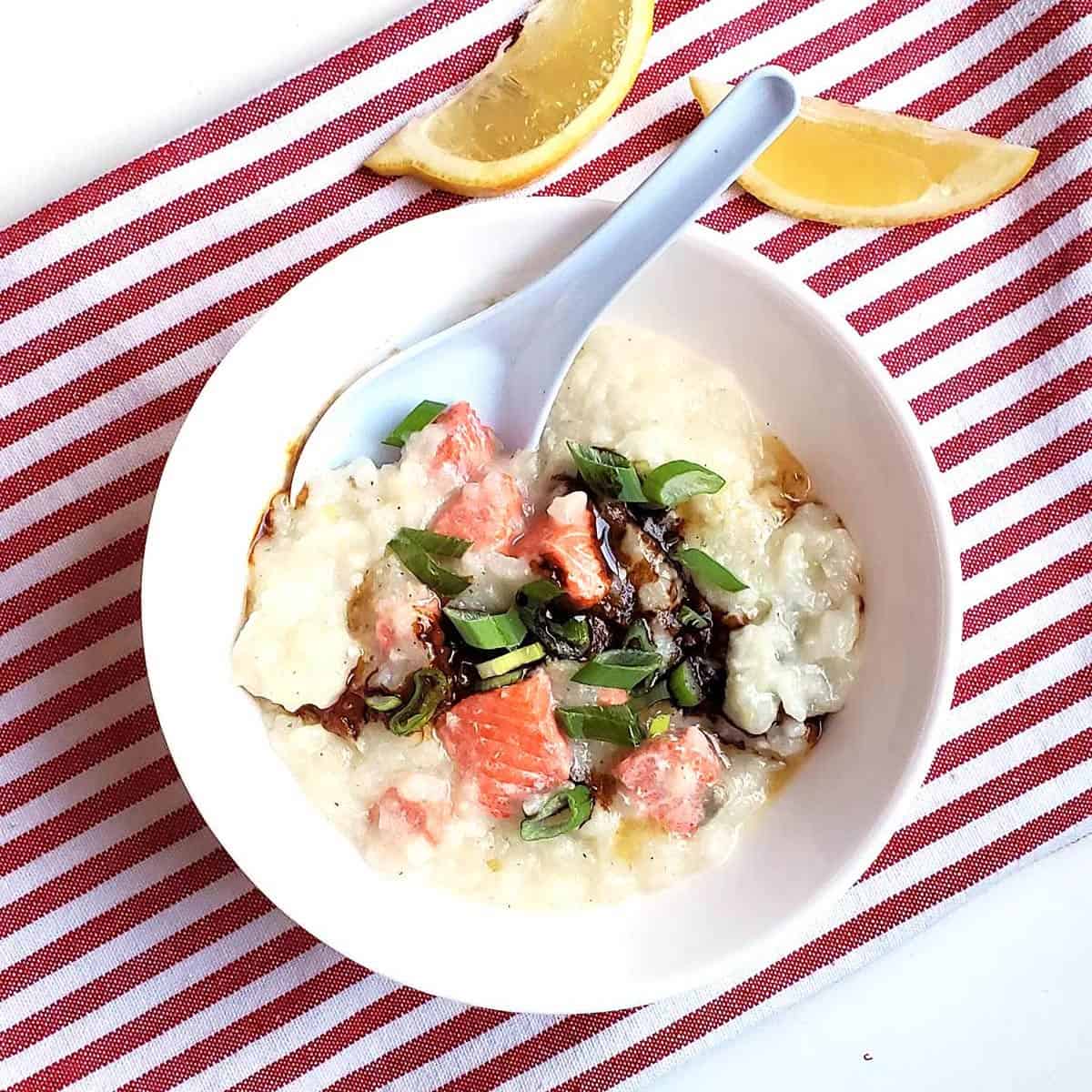
You will love salmon congee!
This salmon congee recipe is one of those dishes that is very convenient and easy to prepare. First of all, this recipe is an excellent way to use up any leftover rice you may have hanging out in the fridge. Secondly, preparation and clean-up are extremely easy: we use only one pot to prepare this dish! I adore any recipe that involves minimal clean up.
Finally, this fish congee recipe is easily customizable and flexible. We use a variety of toppings, such as fresh vegetables and crispy herbs, to dress this rice porridge. You can go minimalist or use a little bit of everything: choose whichever topping appeals to you!
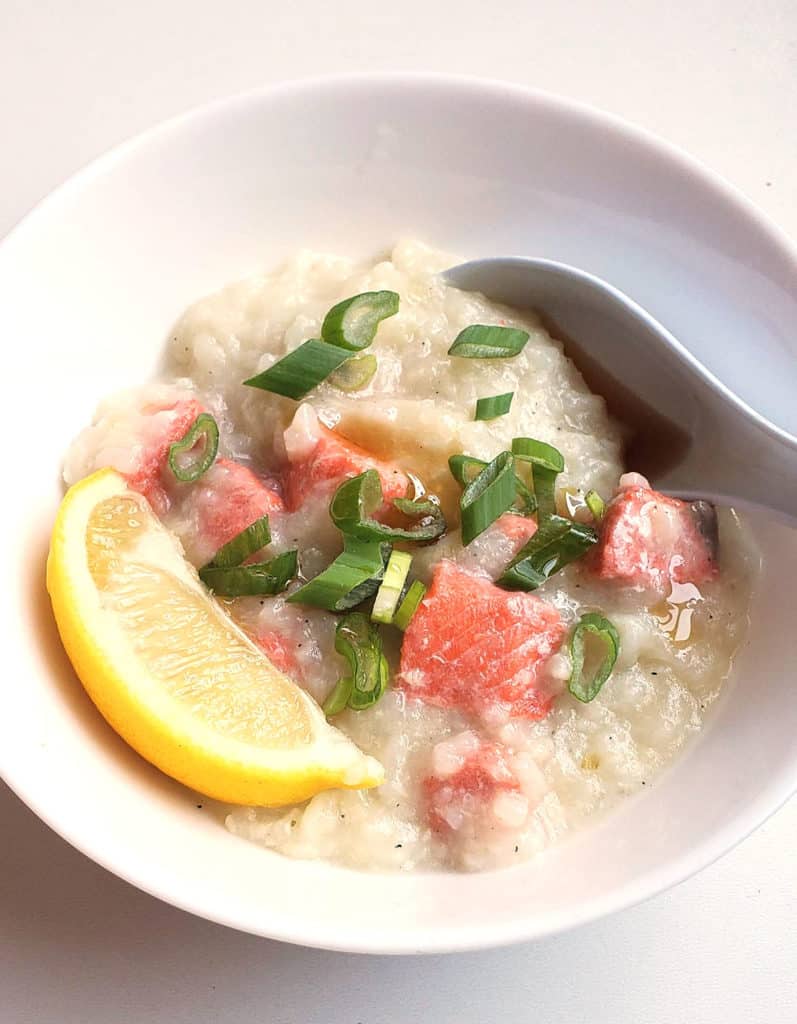
What is salmon congee?
Salmon congee is a comforting, savory, one-pot fish porridge with a consistency similar to oatmeal but with soft bits of rice dispersed throughout. This rice porridge is the perfect base for all kinds of additions and toppings.
Components of congee
Typically, we add some type of protein into congee for extra flavoring and nutrition. Common additions include ground beef, sliced chicken, cubed tofu, marinated fish, or shredded pork. In this fish congee recipe, we instead use nutritious salmon fillets! Fresh salmon fillets are cubed and then added into the fish congee shortly before serving.
This warm, rice porridge is usually dressed with delicious toppings such as sliced green onions, toasted garlic, chili oil, sesame oil, and soy sauce. Congee is the ultimate comfort food in many parts of Asia.
This rice soup is conveniently made with leftover rice. We add cold rice to a pot containing water, seasoned vegetable broth, chicken broth, or any type of meat stock that can contain aromatics such as garlic and ginger. Any protein additions are also added into the pot. We bring the contents to a boil, and then cover the pot and allow to simmer over low heat for up to an hour. During this time, the rice totally soaks up all of the liquid and becomes a creamy, savory rice porridge.
At this point, ladle the smooth congee into individual bowls, top with all kinds of goodies, and eat with a spoon! This salmon congee recipe is easily adaptable to an instant pot or slow cooker.
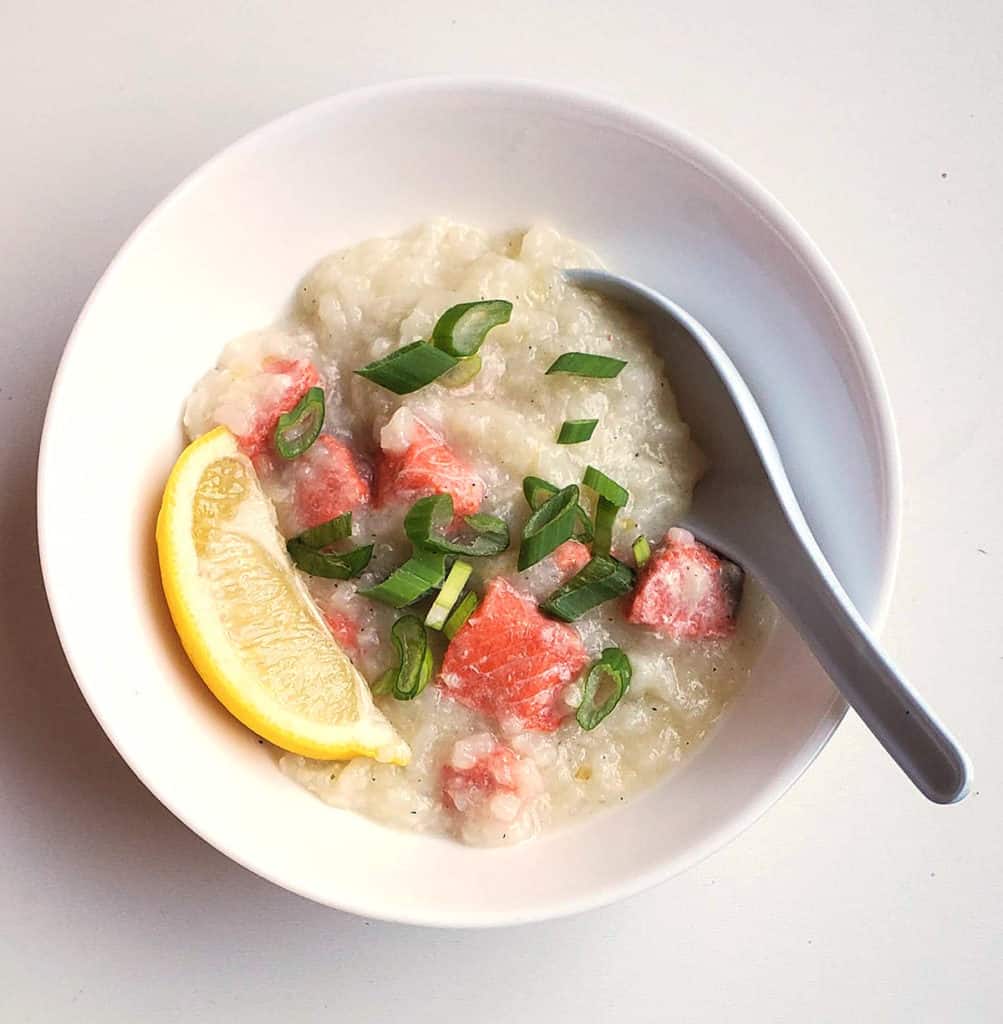
Origins of congee
Congee is a popular dish in many Asian countries such as Japan, China, and the Philippines. In these countries, rice porridge goes by various names including congee, jook, juk, okayu, and lugaw. Each country has its own special variation on the dish – there are Chinese versions, Japanese versions, Filipino versions, and many others!
Many Asian families eat congee any time of day, for breakfast, lunch or dinner. In many Chinese households, this rice soup is often consumed as a warming, comfort food dish during times of illness.
Is Salmon Congee (Fish Porridge) Healthy for You?
Yes, salmon congee is healthy! This fish congee recipe constitutes a super easy, healthy pregnancy soup. Let’s take a closer look at the nutritional highlights of the main ingredient used in this pregnancy recipe: salmon!
Salmon
Most sources say that women should strive to consume 8 to 12 ounces of healthy seafood and fish options every week during pregnancy. Safe seafood and fish options such as salmon provide healthy fats that are good for both mother and baby. Salmon is one of the top choices as a seafood that is high in healthy fats but low in mercury.
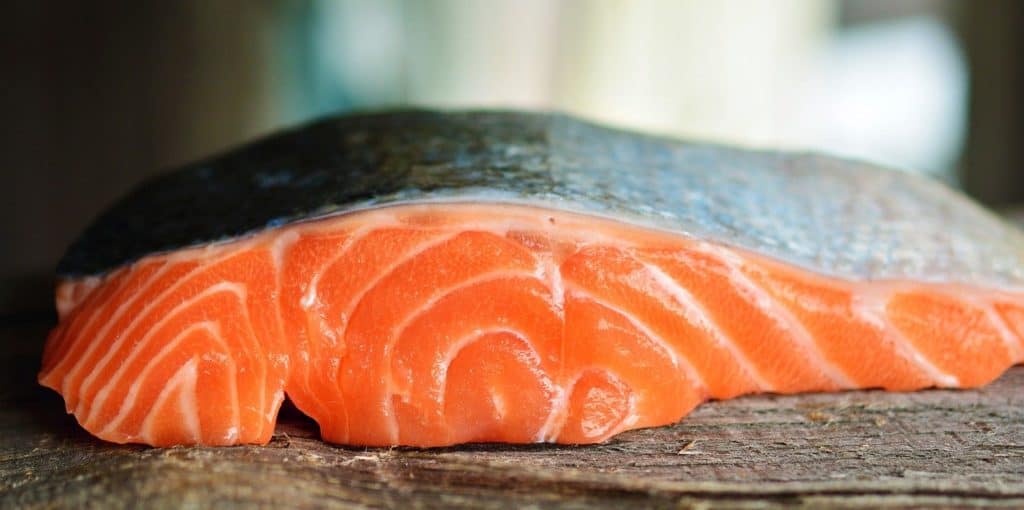
Specifically, salmon is a cold-water fatty fish that is an excellent source of omega-3 fatty acids. These omega 3-s are very important during pregnancy because they are the critical building blocks of the fetal brain and retina.
Salmon is a great source of protein as well. Some studies have shown that prenatal consumption of fish is associated with less intrauterine growth retardation. The importance of protein during pregnancy cannot be overstated. Proper protein intake supports the proper growth of fetal tissues, including baby’s blood supply. This rapid growth of both fetal and maternal tissues requires adequate dietary protein to ensure a positive outcome.
Ingredients to Make Salmon Congee (Fish Porridge)
- 2 cups cooked white rice (short grain or medium grain rice) (350 g)
- 4 cups water or chicken stock (1l)
- 1.5 cups cubed salmon (250 g)
- 1 inch piece of ginger, sliced into coins (10 g)
- 2 garlic cloves, smashed
- 4 sliced green onions (scallions), greens and whites separated
- 1 tablespoon extra virgin olive oil
- 0.5 teaspoon freshly ground black pepper
- 1 tbsp fish sauce - optional garnish
- Lemon – optional garnish
- Soy sauce – optional garnish
- Sesame oil – optional garnish
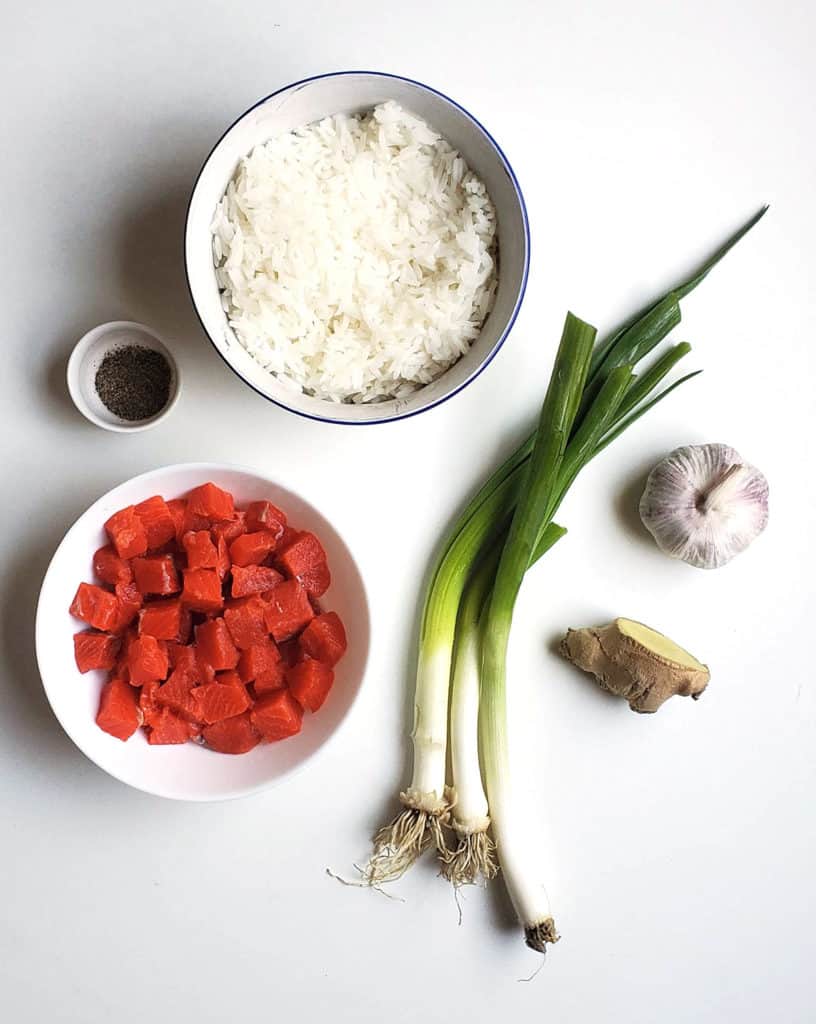
Recommended Tools to Make Salmon Congee
- You’ll need a large pot with a lid. An enameled cast iron dutch oven will do the trick.
- This stainless steel ladle is a high quality tool that will last you for years to come.
- I’m a fan of this garlic press that will either mince or slice your garlic cloves with one simple squeeze. Your choice!
- These jade green Asian soup spoons are so beautiful and will make your meal extra special!
Instructions on How to Make Salmon Congee (Fish Porridge)
Step 1: Sauté aromatics
In a large pot over medium heat, sauté the sliced scallion whites, smashed garlic, and sliced ginger coins in one tablespoon of extra virgin olive oil for two minutes. Sprinkle in the black pepper.
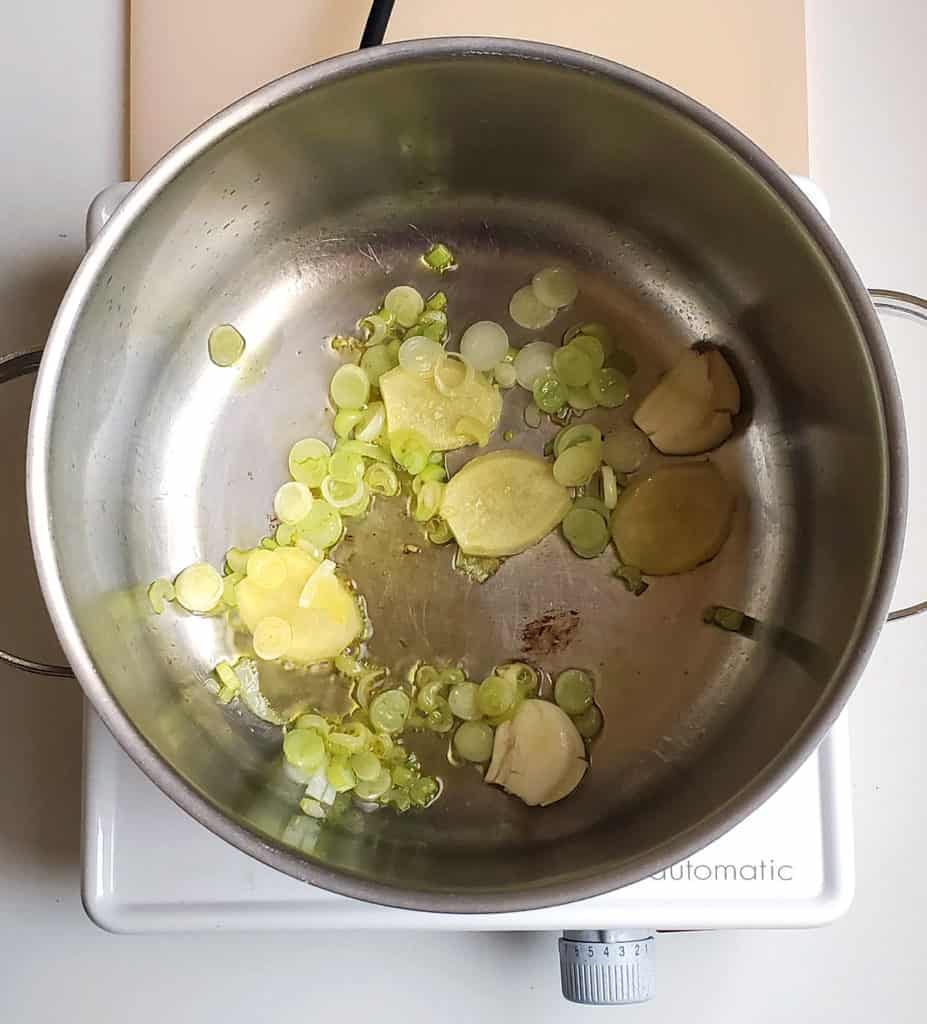
Step 2: Add chicken stock
Next, add the four cups water or chicken broth and mix to release any green onions which may have become stuck to the bottom of the pot.
Step 3: Add in cooked white rice
Then, add in the two cups of cooked rice and stir until dispersed. Allow rice soup to come to a boil.
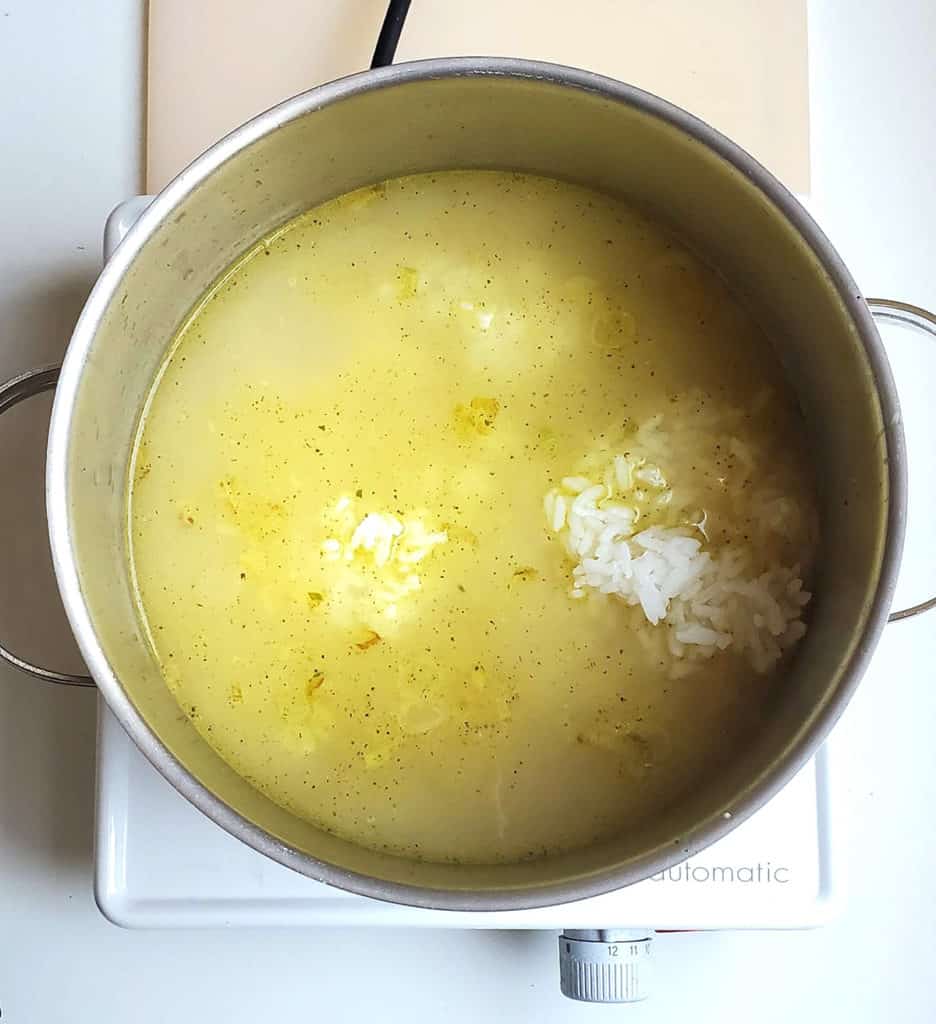
Step 4: Cover and simmer
Once soup has come to a boil, reduce heat to low and then cover the pot. Allow congee to simmer for 45 minutes, stirring occasionally to prevent the rice from sticking or burning.
Step 5: Add the salmon
Remove lid and stir. The congee should have a thick, creamy consistency. Add in the cubed fish fillets. Stir to ensure that the salmon is evenly distributed. Cover pot and allow congee to cook for an additional 5 minutes. The salmon fish should be fully cooked, opaque in color, and flake easily. The USDA recommends a minimum internal temperature of 145 degrees Fahrenheit for cooked salmon.
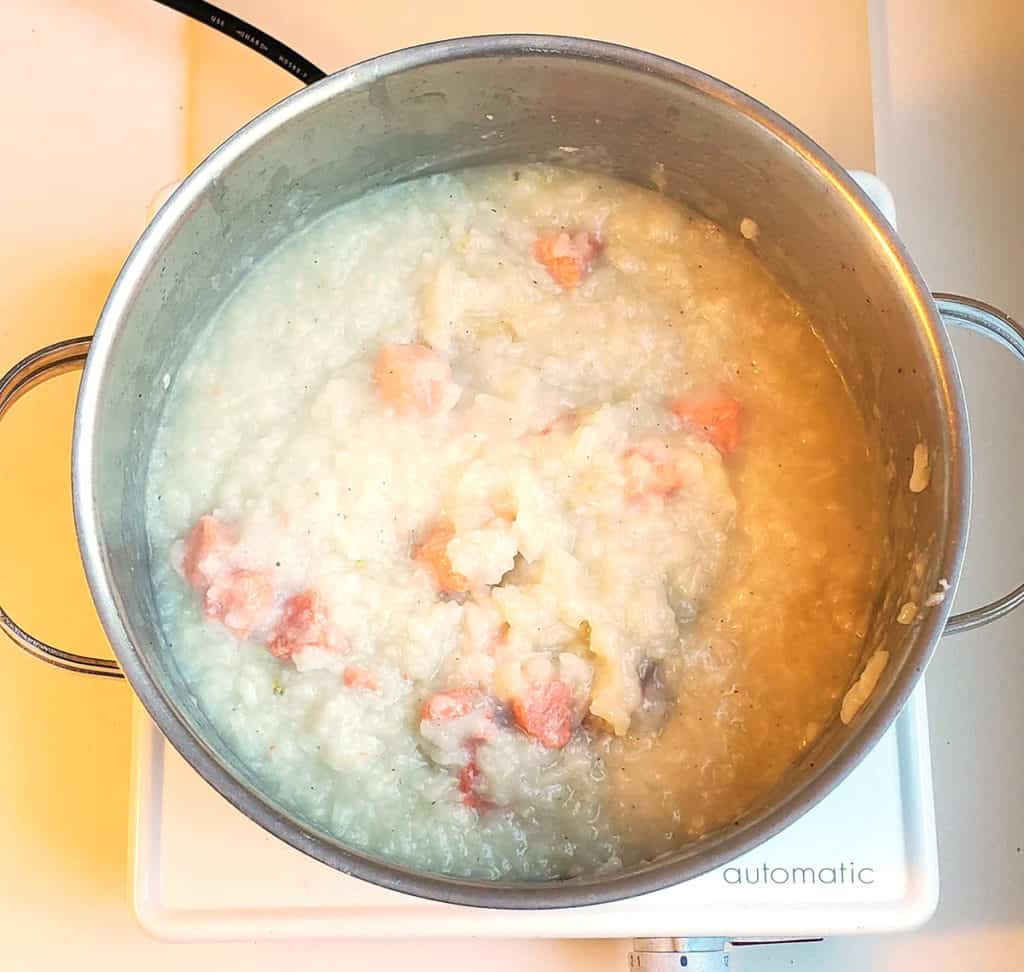
Step 6: Remove aromatics and serve
Finally, remove the ginger and smashed garlic (optional) and discard. Serve individual bowls of salmon congee with chili oil, sriracha, sliced scallion greens, toasted garlic chips, dark soy sauce, toasted sesame oil, and fresh lemon wedges.
How to Serve Salmon Congee (Fish Porridge)
Salmon congee is so delicious on its own, but is also good with:
- Fresh lemon wedges or lime wedges, which provide a refreshing pop of citrus
- A drizzle of toasted sesame oil which adds a savory, nutty flavor to the salmon congee
- A few drops of dark soy sauce or fish sauce which adds a salt, umami flavor to the soup
- Sliced green onions heaped on top add freshness, color, and crunchy texture to the congee
- Toasted garlic or fried crispy onion for an appealing earthy flavor and aroma
- Crispy fried dough sticks which are awesome dipped into this fish porridge
- A sprinkle of white pepper for an extra kick
- Extra crispy fish fillets sliced and placed on top
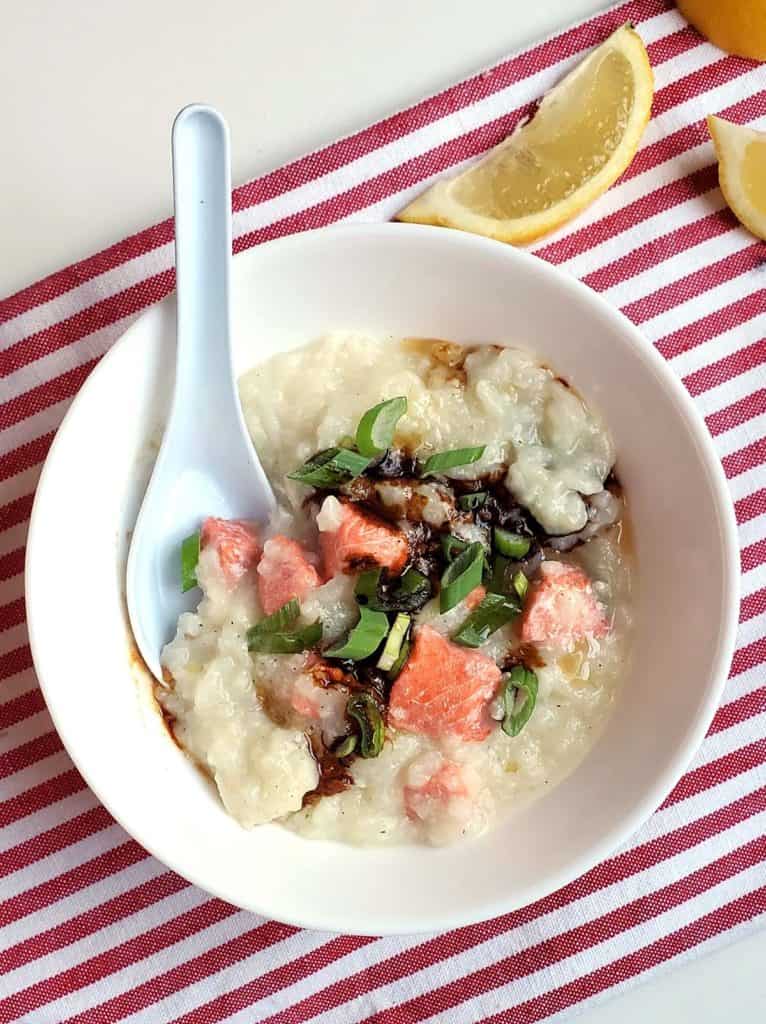
Recipe Variations
Some ideas on variations include:
- Replace the salmon with a different type of fish. If salmon is not available to you, then replace it with another comparable fish, such as cod or rockfish.
- Try using a different type of rice. Brown rice would yield a less smooth rice porridge with more granular texture.
- Vegetarian? Use vegetable broth instead of chicken broth or meat stock. You can even use plain water. Instead of salmon, mix in some diced tofu! Feel free to experiment. Congee is so versatile and complimentary to a wide variety of delicious ingredients.
Make Ahead and Storage
Can congee be refrigerated?
Yes, store any leftover fish porridge in the refrigerator for up to two days. Be sure to store it in an airtight, glass container.
- Reheat: Warm up cold congee on the stovetop. If necessary, add in additional water or chicken broth in order to thin out the congee.
Can congee be frozen?
Yes, leftover fish porridge which has cooled to room temperature can be stored in the freezer for up to three months. Store it in an airtight, freezer-safe container.
- Reheat: Allow congee to thaw in the fridge for several hours. After the congee is defrosted, warm up the congee on the stovetop, adding in additional water or chicken broth in order to thin out the soup, if necessary.
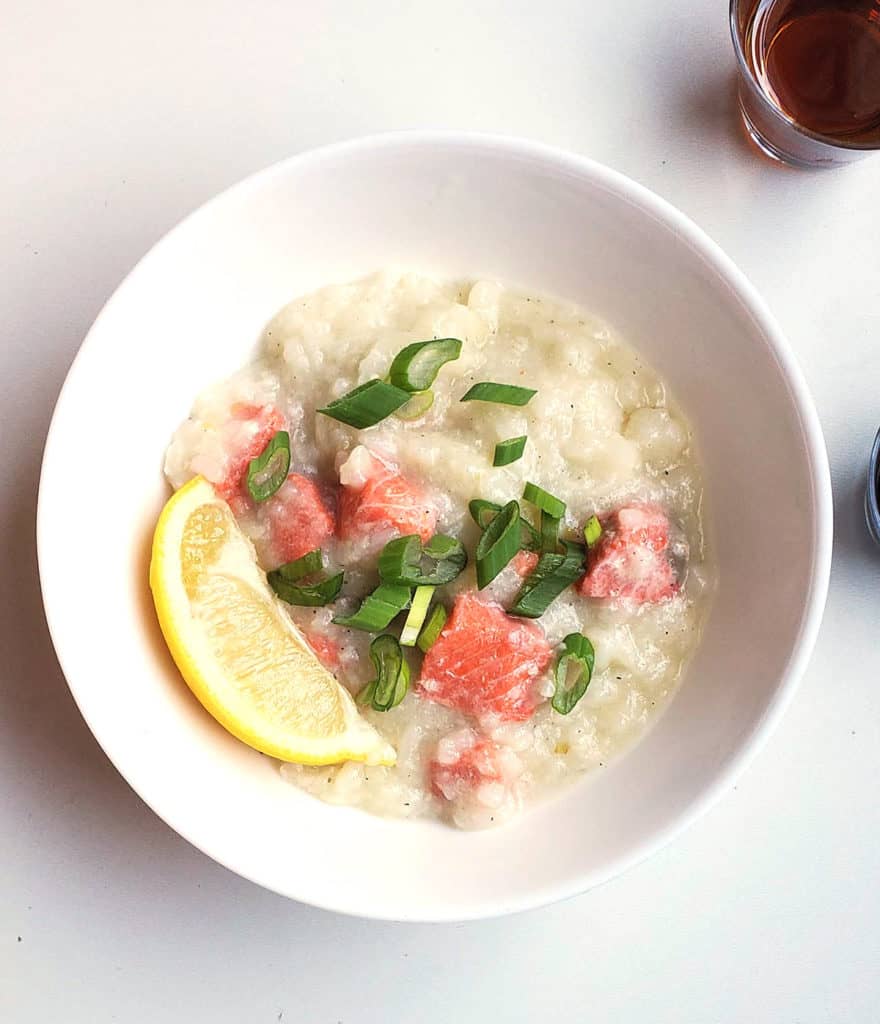
Frequently Asked Questions About Salmon Congee (FAQ)
Can congee be made with basmati rice?
Absolutely, it is possible to make congee using basmati rice. However, basmati rice possesses less starch than other starchier types of rice so the rice granules will likely remain intact. A rice congee made with basmati rice will be more of a rice soup than a starchy porridge. Personally, I usually use jasmine rice because it’s what I always have on hand, and also because I really like the fragrance of jasmine rice.
However, short grain or medium grain varieties also work really well. Short grain varieties such as arborio and sushi rice are good options. Moreover, a starchy, short grain or medium grain rice will result in a creamier fish porridge. Just be aware that different varieties of rice will yield different textures in the congee outcome. Have fun and experiment, it will still taste good!
Do you always cover congee when cooking?
You need to cover the congee in order to allow the cooked rice to absorb the water or cooking liquid. If you don’t cover the pot, then the liquid will evaporate and the rice will not reduce down into your desired fish porridge.
Can congee be eaten cold?
Warm that congee up! Cold congee will have a gel-like texture which some may find unappealing. Reheat the rice porridge in a pot over medium heat, and then add in some chicken stock or water to thin it back out.
You'll Also Love These Related Pregnancy Seafood Recipes
Recipe
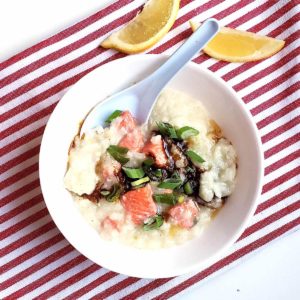
Salmon Congee (Fish Porridge)
Author:Ingredients
- 2 cups cooked white rice (short grain or medium grain)
- 4 cups water (or chicken stock)
- 1.5 cups salmon, cubed
- 1 tbsp ginger, sliced into coins
- 2 garlic cloves, smashed
- 4 green onions, sliced, greens and whites separated
- 1 tbsp extra virgin olive oil
- .5 tsp ground black pepper
- Lemon – optional garnish
- Soy sauce – optional garnish
- Sesame oil – optional garnish
Instructions
- In a large pot over medium heat, sauté the scallion whites, garlic, and ginger in 1 tablespoon of extra virgin olive oil for two minutes. Sprinkle in the black pepper.
- Pour in the four cups water or chicken stock and mix to release any onions which may have become stuck to the bottom of the pot.
- Add in the two cups of cooked rice and stir until dispersed. Allow soup to come to a boil.
- Reduce heat to low and cover the pot. Allow to simmer for 45 minutes, stirring occasionally to avoid burning.
- Remove lid and add in the cubed salmon. Stir to ensure that the salmon is evenly distributed.
- Allow congee to cook for an additional 5 minutes. The salmon fish should be fully cooked, opaque in color, and flake easily.
- Remove the ginger and smashed garlic (optional) and discard.
- Serve individual bowls of salmon congee with chili sauce, sriracha, sliced green scallions, toasted garlic, soy sauce, sesame oil, and lemon wedges.


Leave a Reply